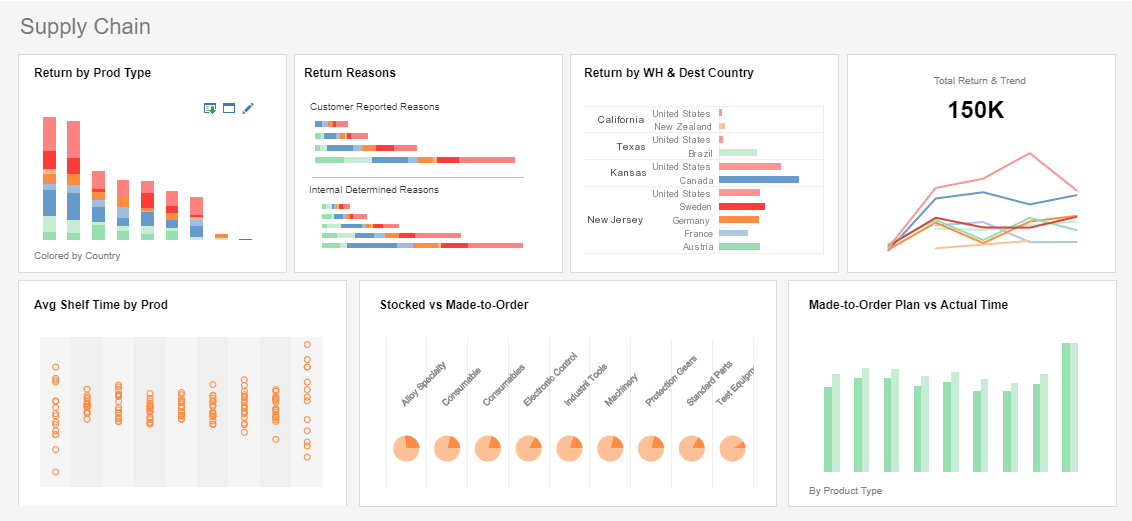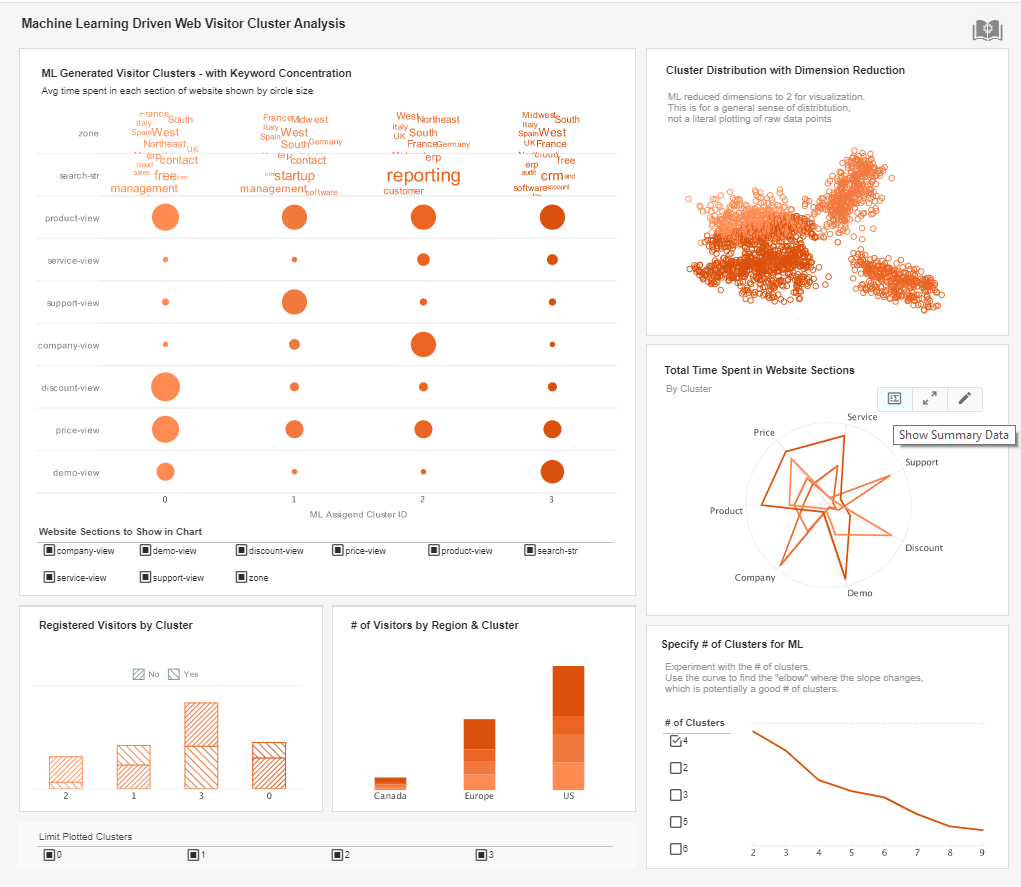Operational BI Reporting Tool
Operational business intelligence, also referred to occasionally as real-time business intelligence, is a style of data analysis that facilitates decisions based on the real-time data companies generate on a routine basis. Operational business intelligence data is most useful to front-line workers who require up-to-date information to perform well.
Operational BI has the unique capability to take place alongside business processing activities. Problems can be spotted as they occur, rather than through the after-the-fact analysis of traditional business intelligence approaches. Decision makers can make quick decisions and see the immediate results of those actions.
| #1 Ranking: Read how InetSoft was rated #1 for user adoption in G2's user survey-based index | Read More |
Real-Time Reporting | Operational Business Intelligence in Action
InetSoft's StyleBI is a complete BI suite, providing users with a secure, easy-to-use, real-time reporting tool. StyleBI enables high-level exploratory analytics and flexible reporting that provides decision makers with the ability to quickly act on insights through manual or automated means.
Real-Time Data Access Engine | Connect to Any Data Source
Style intelligence features live data access to relational data bases (JDBC), multidimensional databases, Hadoop/HIVE, XML, Microsoft Excel, OLAP cubes, SAP, PeopleSoft, JD Edwards, salesforce.com, Siebel CRM, Postgress, Google Ads, Google Analytics, and Microsoft Sharepoint. Additional data sources are accessible through custom implementation and/or third party connectors.
Reporting Features | Advanced Capabilities
• Business Logic - add server-side JavaScript for run-time presentation control
• Bursting - generate high volumes of customized reports efficiently
• Modular Design - combine elements such as tables and charts to create a complete report
• Scheduling - monitor and schedule batch report generation with multiple output and delivery
channels
• Multiple Crosstab Aggregations - data aggregation and multiple levels of grouping in both
directions
• Export Formats - export reports to PDF, Excel, PowerPoint, HTML, CSV, XML, text, etc.
• Chart Styles - choose from more than 30 chart styles (bar, pie, line, scatter, bubble, etc.)
• Formula Tables - use formulas in a spreadsheet-like manner to present dynamic data
• Parameter Sheets - simple or multi-level parameter prompting based upon user input
About InetSoft
Since 1996 InetSoft has been delivering easy, agile, and robust business intelligence software that makes it possible for organizations and solution providers of all sizes to deploy or embed full-featured business intelligence solutions. Application highlights include visually-compelling and interactive dashboards that ensure greater end-user adoption plus pixel-perfect report generation, scheduling, and bursting.
InetSoft's patent pending Data Block™ technology enables productive reuse of queries and a unique capability for end-user defined data mashup. This capability combined with efficient information access enabled by InetSoft's visual analysis technologies allows maximum self-service that benefits the average business user, the IT administrator, and the developer. InetSoft solutions have been deployed at over 5,000 organizations worldwide, including 25% of Fortune 500 companies, spanning all types of industries.

What KPIs and Metrics Are Tracked by Life Support Systems Manufacturers?
Life support systems manufacturers produce critical equipment that ensures the safety, health, and survival of individuals in various challenging environments, such as medical settings, military operations, and space missions. Tracking Key Performance Indicators (KPIs) and metrics is vital for these manufacturers to maintain high standards of quality, efficiency, and reliability. Here, we delve into the KPIs and metrics commonly monitored by life support systems manufacturers, their definitions, and their significance in performance management.
1. Product Quality
Definition: The measure of how well the life support systems meet the required standards and specifications.
Significance: High product quality is essential to ensure the reliability and safety of life support systems. Quality metrics include defect rates, the number of returned products, and customer complaints. Maintaining high product quality reduces the risk of failures in critical situations and enhances the manufacturer's reputation.
2. Production Yield
Definition: The percentage of products that meet quality standards out of the total produced.
Significance: Production yield reflects manufacturing efficiency and the effectiveness of production processes. High yields indicate that the production process is well-controlled and that there are fewer defects or errors, leading to cost savings and higher profitability.
3. Time to Market
Definition: The duration from the initial product concept to the product's availability for sale.
Significance: Reducing time to market is crucial for staying competitive. Faster development and deployment can meet urgent needs and capitalize on market opportunities. This KPI measures the efficiency of the product development process and the ability to quickly adapt to market demands.
4. Lead Time
Definition: The time taken from receiving an order to delivering the product.
Significance: Short lead times improve customer satisfaction and operational efficiency. It indicates the effectiveness of the supply chain and manufacturing process. Shorter lead times can provide a competitive advantage by enabling faster response to customer needs.
5. Customer Satisfaction
Definition: The measure of how satisfied customers are with the products and services provided.
Significance: High customer satisfaction leads to repeat business, positive word-of-mouth, and brand loyalty. This KPI is typically measured through surveys, feedback, and Net Promoter Scores (NPS). It helps in understanding customer needs and improving product and service quality.
6. Compliance Rate
Definition: The percentage of products and processes that meet regulatory and industry standards.
Significance: Compliance with regulations ensures the safety and legality of the products. A high compliance rate mitigates the risk of legal issues, fines, and reputational damage. It reflects the organization's commitment to adhering to standards and regulations, which is critical in the life support systems industry.
7. First Pass Yield (FPY)
Definition: The percentage of products that pass quality inspections and tests the first time without requiring rework.
Significance: FPY is an indicator of process efficiency and quality. High FPY rates mean fewer resources spent on rework, lower costs, and faster production cycles. It signifies a well-controlled manufacturing process.
8. Inventory Turnover
Definition: The ratio of the cost of goods sold to the average inventory value.
Significance: High inventory turnover indicates efficient inventory management, reducing holding costs and the risk of obsolescence. It reflects the effectiveness of demand forecasting and supply chain management.
9. Downtime
Definition: The amount of time that production equipment is not operational due to maintenance or failures.
Significance: Minimizing downtime is crucial for maintaining production schedules and meeting delivery targets. It affects overall productivity and operational efficiency. Monitoring downtime helps in identifying and addressing the causes of production delays.
10. Capacity Utilization
Definition: The percentage of the manufacturing capacity that is actually used over a given period.
Significance: High capacity utilization indicates efficient use of resources and production capabilities. It helps in planning for future capacity needs and optimizing operational efficiency. Low utilization may suggest underused resources or inefficiencies in the production process.
11. Cost of Poor Quality (COPQ)
Definition: The total cost associated with defects and non-conformance, including rework, scrap, and warranty claims.
Significance: Reducing COPQ improves profitability and quality. It highlights areas where quality improvements can lead to significant cost savings. Tracking COPQ helps in identifying and eliminating sources of waste and inefficiency.
12. Supplier Performance
Definition: The measure of how well suppliers meet the manufacturer's requirements in terms of quality, delivery, and cost.
Significance: Reliable suppliers are critical for maintaining production schedules and product quality. Supplier performance metrics include on-time delivery rates, defect rates, and responsiveness. Good supplier performance ensures a smooth supply chain and consistent product quality.
13. Employee Productivity
Definition: The amount of output produced per employee or per labor hour.
Significance: High employee productivity indicates efficient use of human resources and effective workforce management. It helps in identifying areas for improvement in training, processes, and workforce allocation.
14. Health and Safety Incidents
Definition: The number of accidents, injuries, or health-related incidents occurring within the manufacturing facility.
Significance: Ensuring a safe working environment is paramount. High rates of incidents can lead to production stoppages, legal issues, and reduced employee morale. Monitoring health and safety incidents helps in maintaining a safe workplace and complying with safety regulations.
15. Energy Consumption
Definition: The amount of energy used in the production process.
Significance: Efficient energy use reduces operational costs and environmental impact. Tracking energy consumption helps in identifying opportunities for energy savings and sustainability improvements.
16. Waste Reduction
Definition: The amount of waste produced during the manufacturing process and the effectiveness of waste reduction initiatives.
Significance: Reducing waste lowers disposal costs, improves environmental sustainability, and increases overall efficiency. It reflects the effectiveness of lean manufacturing practices.
17. On-Time Delivery Rate
Definition: The percentage of orders delivered to customers on or before the promised delivery date.
Significance: High on-time delivery rates enhance customer satisfaction and reliability. It indicates the efficiency of the production and supply chain processes.
18. Return on Investment (ROI)
Definition: The ratio of net profit to the total investment in the manufacturing processes and facilities.
Significance: ROI measures the profitability and efficiency of investments in production capabilities. High ROI indicates that the company is making wise investment decisions and achieving good financial returns.
19. R&D Effectiveness
Definition: The measure of the success rate of research and development projects in terms of new product launches, patent filings, and market impact.
Significance: Effective R&D is crucial for innovation and staying competitive. It reflects the company's ability to develop new products that meet market needs and regulatory standards.
20. Training and Development
Definition: The amount of time and resources invested in employee training and skill development.
Significance: Continuous training and development ensure that employees are skilled and up-to-date with the latest technologies and practices. It improves productivity, quality, and job satisfaction.
More Articles About Operational Reporting
BI Vendor Worldwide - InetSoft's state-of-the-art software application, StyleBI, utilizes powerful data manipulation tools that enable large amounts of data to be explored and analyzed in a time-efficient manner, providing advantageous insights and meaningful information. This agile software is essential to an organization's needs; it strengthens the functionality and efficiency of business operations...
Collaborate Via Dashboards - The InetSoft server is a collaboration tool. So I can publish this dashboard up to the server. And then different people could look at it, they could comment on it, they could filter it, all of the interactivity that you see here like this quick filter and the interactivity that we defined, going from the top to the bottom view, all of that exists on server. It's a way to share results of an analysis very widely and still provide that interactivity to people...
The Data Explosion - The other thing I think of a lot is the population of the world which is estimated to be seven billion people. That's a lot of people. How many of those people ultimately are the ones that generate data? How many of those seven billion people are actually connected? I mean there are billions that don't even have access to the Internet yet, but they are getting it. One projection I saw was that there will be a billion smart devices on the planet in a year...
What Does a Data Mashup Permit? - Data mashup allows users to go far beyond the limitations of IT created obstacles, such as waiting on unnecessary change requests, work backlogs, and administrative overhead. End user driven data mashup provides features that will benefit any business, including...
Why Mobile BI - Today, we are going to discuss a new trend that we have been seeing on the market in the last few years, tablets and mobile BI. A lot of analysts predict that mobile market is going to grow exponentially in the near future, and a lot of CEOs and CIOs are starting to wonder how to leverage this trend in different areas, in BI analytics in particular. I would like to begin our presentation with some data...



